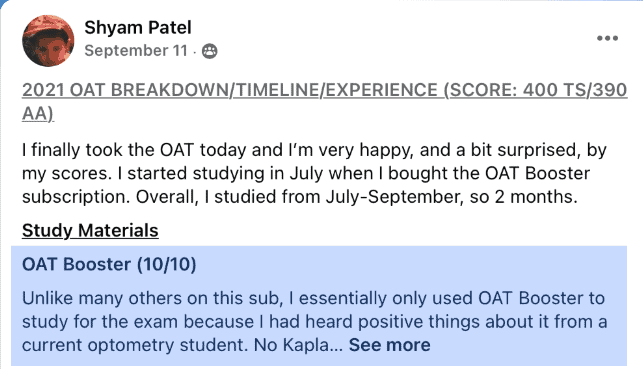Are you wondering how hard the OAT test is?
Well, it’s normal for pre-optometry students to feel worried about the OAT exam as it’s the only test that stands between you and your dream optometry school.
Additionally, preparing for the OAT can feel overwhelming, especially when juggling between work, school, and your social life.
This OAT prep guide gives you an in-depth look at how hard the actual OAT exam is, the most challenging sections, and how to make the preparation process easier for you. Here’s what to expect:
Quick Summary
- Biology is the most detailed subject in the OAT.
- It’s recommended to take 2-4 months or 150-200 hours to prepare for the OAT.
- Most students find the optometry admission test to be hard as it weighs heavily on physics and math.
- The OAT is a long test that requires a lot of stamina to study and pass.
How Hard Is The OAT Test?
In truth, your level of preparation will determine how difficult you find the actual OAT exam.
Some students struggle with basic mathematical concepts, while others find it challenging to ace the reading comprehension section. That’s why we recommend taking as many practice tests as possible ahead of the actual OAT exam to identify your strengths and areas where you need more work.
This article gives pre-optometry students a closer look at the expected difficulty level in the actual OAT exam, whether you’re self-studying, taking an OAT prep course, or in-person classes.
What Factors Make The OAT Hard?
Here are several factors that make the OAT hard for most pre-optometry students:

1. It Weighs Heavily On Physics And Maths
Most pre-optometry students find the OAT hard to study and pass as it weighs heavily on math and physics.
Both sections have lots of conceptual questions and you’ll need to be quick at identifying the right formulas to use on the given problems.
Unfortunately, some questions can take too long to solve and require analytical thinking to solve, but you’ll also need strong memorization skills.
2. It’s A Standardized Test
The OAT is a standardized entry exam where your scores are compared to other test takers when joining the optometry school.
That makes it hard to know whether you’ve prepared enough to secure admission to your dream optometry program as it all depends on the performance of other applicants.
3. It’s A Long Test That Requires Stamina
The OAT test highly depends on memorization skills, which require a lot of mental stamina to pass.
Most questions test on the concepts that you’ve already learnt, but you’ll need to be quick at remembering the answers tested.
What Is The Most Difficult Section In The OAT?
Most students agree that quantitative reasoning is the hardest part of the actual OAT exam, as many of us forget that it’s a mathematical reasoning section.
However, the physics section has proven the hardest for thousands of pre-optometry students, no matter the level of preparation.
On my part, I realized the physics section tests almost every concept in the subject. That means pre-optometry students need enough time to understand the basic concepts, as many questions in this section depend on your rationalization.
How Long Does It Take To Prepare For The OAT?
It takes 2-4 months to prepare for the OAT exam fully. However, the time you spend preparing for the actual OAT exam depends on the type of student you are, your study schedule, and your strength areas.
Students who choose to study for 2-4 hours daily can easily ace the OAT tests in 2-4 months, but you’ll need a detailed study calendar.
Pre-optometry students must also set a day of rest to avoid feeling overwhelmed in their quest. However, you’ll need extra time for subjects you find challenging.
Exclusive Deal: Get 10% OFF one of the best OAT prep online tools, if not the best.
Pros
Highly representative tests and questions.
Regularly updated every year.
Everything you need all in one simple-to-use online study tool
Cons
No live classes
Use code at checkout: TESTPREPPAL
How Many Schools Require The OAT Exam?
All 20+ optometry programs in the US require students to pass the OAT exam before joining them. Canada’s University of Waterloo and Puerto Rico’s Interamerican university also require pre-optometry students to take the OAT.
However, it’s hard to know whether your OAT score is enough to join your dream optometry school as it depends on several factors.
Remember that multiple factors affect whether your OAT score is good enough to join an optometry program. That includes your score and percentile ranking compared to other applicants, although that’s not the metric for applicant comparison.
Since 300 corresponds to 50%, most students aim for anything above that. However, we recommend aiming for a score above 350 for competitive optometry programs like the University of Waterloo, where more than half of the applicants are rejected.
However, what some optometry schools consider a high score might be low in other schools.
How To Make The OAT Less Difficult
The best way to make the optometry admission test less difficult is to have enough preparation using OAT practice tests, books, and online prep courses.
We recommend starting by understanding the basic concepts and taking enough practice tests before the test day to know whether you’re ready. However, studying for the OAT can be challenging without a proper schedule.
Besides going through the basic concepts and taking practice tests, you’ll need time to review the materials and understand why you got an answer right or wrong.
You also need to be realistic with your study progress. Additionally, don’t be afraid to temporarily skip a question on the test day to avoid unnecessarily wasting time.

Ways To Make OAT Preparation Less Difficult
Studying for the optometry admission test can prove to be daunting, as there is a wide range of concepts to grasp.
However, you can simplify the studying process by knowing what to expect in every section, using the right study materials, and having a dedicated study schedule.
Here are all the OAT study materials we recommend for students seeking to join their dream optometry schools. These study materials include OAT prep courses, books, full-length practice tests, and videos.
1) Know What To Expect In Every Section
Here’s what to expect from every section:
- Biology
The biology section is specific but also features a range of broad topics. Be sure you know structures, hormones, biomes, taxonomy, and a few lab questions.
We recommend watching the bio videos and bio bites included in the OAT Bootcamp or Chad’s videos, as they do an excellent job explaining everything you need to know.
- General Chemistry
The actual exam includes lots of calculations in general chemistry, but there are no curve balls, even with difficult questions.
Chad’s videos are excellent for studying this section, but you might need other materials like OAT Destroyer or OAT Bootcamp. It helps to memorize the formula sheet and go through enough practice tests using the formulas.
- Organic Chemistry
Most people hate organic chemistry and hardly look forward to studying this section. The key in this section is to know reactions well and practice using OAT Bootcamp and OAT Destroyer practice tests.
- Physics
This section is the most challenging part for most students, although most of the physics equations are straightforward.
You can expect questions ranging from thermodynamics to kinematics, forces, lenses, mirrors, and others. We recommend mastering quotations of free body diagrams in different conditions.
- Reading Comprehension
The reading comprehension section is easy to ace with the search and destroy strategy, but you’ll need proper time management to complete all the passages.
As such, avoid unnecessarily skipping any passage as it might be hard to return to it.
- Quantitative Reasoning
The quantitative reasoning section features a mix of everything, with most questions taking basic mathematical concepts to complete in a few steps.
We highly recommend using OAT Destroyer and OAT Bootcamp to learn quick methods to solve the questions.
2) Use The Right Study Materials
- OAT Prep Courses
Commercial OAT prep courses are available as self-paced online courses, in-person classes, or a combination of both and their prices differ significantly.
These courses are an excellent way to find directions and easily understand all the basics using a dedicated study schedule.
Some of the best OAT prep courses that we recommend include OAT Bootcamp and Kaplan OAT.
These prep courses help you familiarize yourself with different concepts while offering you lots of practice tests and advice on how to score high on the OAT.
- Practice Tests
While commercial OAT prep courses offer helpful advice and practice tests, it’s wise to try as many tests as possible.
The ADA practice test packs are an excellent choice when looking for more practice tests in any section, ranging from organic chemistry to reading comprehension.
- OAT Flashcards
Studies show that repetition is among the most effective methods of learning and flashcards are the best when it comes to repetition.
OAT flashcards use repetitive study methods to help you break down difficult test questions and solve them quickly on the test day.
- Online Videos
Videos help our brains to process information more efficiently and easily recall it. Chad’s videos are an excellent resource for learning natural sciences. In the OAT, they’re highly useful for physics, organic chemistry, biology, and general chemistry.
- OAT Prep Books
While reading a book might seem boring, OAT prep books are great for students looking for an in-depth guide on any topic.
For instance, the Kaplan OAT gives you a comprehensive review of the topics and the practice tests help you find ways to simplify even the toughest questions.
Tips And Strategies To Ace The OAT
Study For At Least 200 Hours
While some students might not have enough time to go through all the study materials before the test day, we recommend studying for at least 200 hours.
Consider dividing your study time into three phases, with the first phase concentrating on understanding the basic concepts.
The second phase should concentrate on taking practice tests and reinforcing your knowledge of sections you haven’t fully understood.
After the second phase, we recommend taking at least 50 hours to take full-length practice tests and review the answers you got wrong or right, focusing on why you passed or failed any section.

Take As Many Practice Tests As Possible
Whether you’re taking a commercial prep course or studying for your OAT, you’ll need to take as many practice questions as possible.
Taking a practice test after every topic will help you familiarize yourself with answering questions, but that’s not how the actual exam goes.
You must be prepared to be proactive and sit down for five hours. Completing as many full-length practice tests as possible helps you prepare mentally and physically.
Make Flashcards For Sections You Struggle With
Flashcards engage you in actively recalling different OAT concepts by stimulating your memory to create lasting connections with your study material.
That’s essential, as the OAT tests your memory skills and requires a speedy response to the questions.
FAQs About The Difficulty Of The OAT Test
What Score Do You Need To Pass The OAT?
A pass in the OAT depends on the optometry school you’re applying to. Most schools consider anything less than 300 as below average, although you might still get a chance to join various optometry schools.
However, that depends on the other applicants, so you should always aim to get at least 320-350 marks when applying to a highly competitive optometry school.
Anything between 350-389 puts you in a highly competitive place to join any optometry school as you’ll be among the top 25% of all students. Anything above that puts you among the top 10 test-takers.
How Hard Is Physics On The OAT?
Physics is among the most challenging parts for most students, but we found most questions easy to understand. You’ll only need to understand physics equations to help you understand and solve free-body diagrams.
How Hard Is The OAT Compared To MCAT?
The MCAT is much harder than the OAT as it’s more rigorous, longer, and doesn’t have clear-cut sections. Unlike the OAT, MCAT requires more applicational thinking than memorization.
The OAT tests you on what you’ve learnt, while the MCAT tests your ability to think and apply what you’ve learnt.
As such, using MCAT study materials to prepare for the OAT is totally fine provided you do some OAT practice tests and brush up on math.
Does The OAT Have A Lot Of Math?
There are lots of math questions in Quantitative Reasoning, Physics, and Chemistry. However, most questions are straightforward and can be solved with a few steps.





